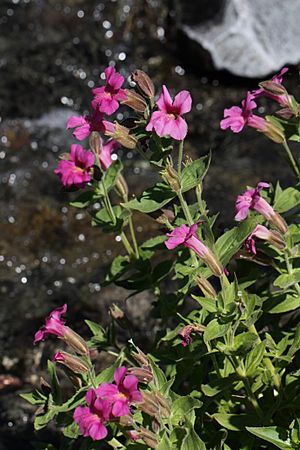Lewis' monkeyflower facts for kids
Quick facts for kids Lewis' monkeyflower |
|
|---|---|
 |
|
| Erythranthe lewisii in Mount Rainier National Park | |
| Scientific classification | |
| Genus: |
Erythranthe
|
| Species: |
lewisii
|
| Synonyms | |
|
|
The Lewis' monkeyflower (Erythranthe lewisii), also called the great purple monkeyflower, is a beautiful plant. It's a type of perennial herb, which means it lives for more than two years. This plant is part of the Phrymaceae family. It was named after the famous explorer Meriwether Lewis.
Scientists often study the Lewis' monkeyflower to understand how different pollinators (like bees or hummingbirds) help plants create new seeds and stay separate from other similar plants. It used to be known as Mimulus lewisii.
Contents
What it Looks Like
The Lewis' monkeyflower is a plant that grows from about 25 to 80 centimeters (about 10 to 31 inches) tall. Its leaves are usually between 20 and 70 millimeters (about 0.8 to 2.7 inches) long. The whole plant is covered in tiny, soft hairs.
Its flowers are a medium size and sit on long stems called pedicels, which are about 30 to 70 millimeters (1.2 to 2.7 inches) long. The flowers can be light pink, especially in the Sierra Nevada mountains, or a darker purplish-red color, which is more common in the Cascade Range and Rocky Mountains.
Each flower has a special yellow spot on its lower petal. This spot is rich in carotenoids, which are pigments that give things a yellow or orange color. These yellow spots act like "nectar guides," showing bees where to find the sweet nectar. They are also covered in tiny hairs called trichomes. Sometimes, you might even find populations of white-flowered plants, which don't have the purple color.
Where it Grows
The Lewis' monkeyflower is native to western North America. You can find it from Alaska all the way down to California and over to Colorado. It loves to grow in wet places, like along streambanks. You'll usually see it in higher, mountainous areas.
In the Sierra Nevada mountains in California, the Lewis' monkeyflower grows in the same areas as its close relative, the Scarlet monkeyflower (Erythranthe cardinalis).
How it Reproduces (Pollination)
The Lewis' monkeyflower is pollinated by bees. The main bees that visit it are bumblebees and Osmia bees. These bees drink the flower's nectar and, while doing so, pick up and transfer pollen from one flower to another. This helps the plant make seeds.
Even though the Lewis' monkeyflower and the Scarlet monkeyflower can technically create new plants together in a lab, they don't usually mix in the wild. This is mainly because different pollinators visit them. The Lewis' monkeyflower is visited by bees, while the Scarlet monkeyflower is pollinated by hummingbirds. This difference in visitors keeps the two plant types separate in nature.
Uses of the Plant
People sometimes grow the Lewis' monkeyflower in their gardens, especially in places with mild weather or near the coast. It doesn't like long periods of freezing temperatures. In the UK, it has even won an Award of Garden Merit from the Royal Horticultural Society, which is a special award for garden plants. It grows best in very damp soil and full sunlight.
Long ago, some Native American groups would eat the leaves of this plant.
Images for kids
-
Erythranthe lewisii in Mount Rainier National Park


